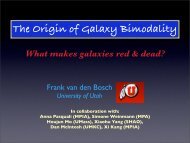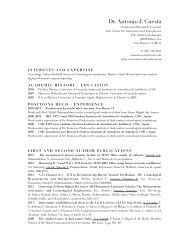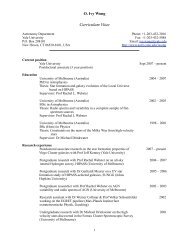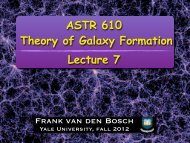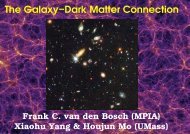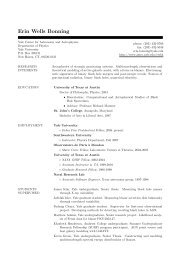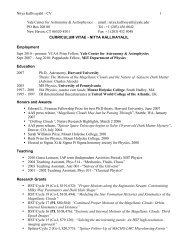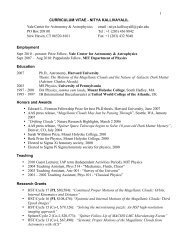ASTR 610 Theory of Galaxy Formation Lecture 16
ASTR 610 Theory of Galaxy Formation Lecture 16
ASTR 610 Theory of Galaxy Formation Lecture 16
You also want an ePaper? Increase the reach of your titles
YUMPU automatically turns print PDFs into web optimized ePapers that Google loves.
Disk Galaxies: Observational Facts<br />
Exponential Surface Brightness Pr<strong>of</strong>iles<br />
Because <strong>of</strong> their close-to-exponential appearance, disk galaxies are <strong>of</strong>ten modelled<br />
as infinitesimally thin, exponential disks:<br />
surface brightness<br />
surface mass density<br />
I(R) =I 0 e −R/R d<br />
Σ(R) =Σ 0 e −R/R d<br />
L d =2π<br />
M d =2π<br />
∞<br />
0<br />
∞<br />
0<br />
I(R) R dR =2π I 0 R 2 d<br />
Σ(R) R dR =2π Σ 0 R 2 d<br />
circular velocity<br />
V 2<br />
c,d(R) =−4πGΣ 0 R 2 d y [I 0 (y) K 0 (y) − I 1 (y) K 1 (y)]<br />
disk scale length<br />
R d stellar mass-to-light ratio M d /L d =Σ 0 /I 0<br />
y ≡ R/(2 R d )<br />
modified Bessel functions<br />
I n (x) K n (x)<br />
The circular velocity curve reaches a maximum at R 2.<strong>16</strong> R d<br />
For more realistic models, with non-zero thickness, see MBW §11.1.1...<br />
<strong>ASTR</strong> <strong>610</strong>: <strong>Theory</strong> <strong>of</strong> <strong>Galaxy</strong> <strong>Formation</strong> © Frank van den Bosch: Yale 2012



